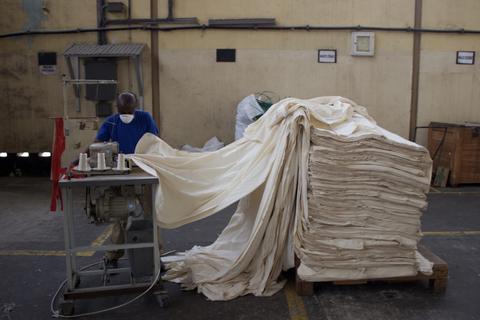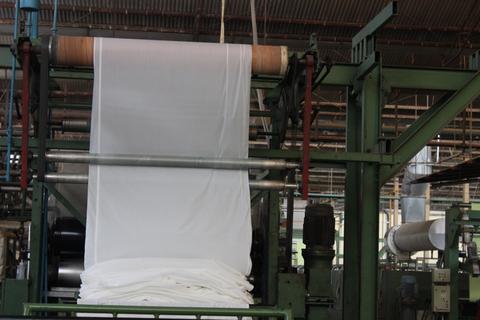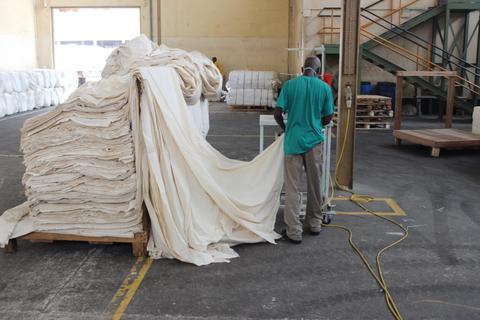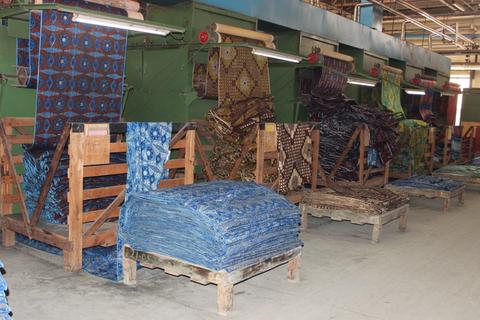A few months ago, I wrote “Dear Afrocentrist, ‘African Prints’ Are Not From Africa,” questioning the authenticity of the colorful fabrics we’ve grown to identify as African prints.

I argued that all African prints were manufactured in China and the only fabrics unique to Africa were cultural fabrics like the Kente and Batakari.
I was wrong.

In the heart of Ghana, is the Ghana Textile Printing Company (GTP), a local manufacturing firm built in 1966 by the Ghanaian government and Vlisco, a European firm. Their partnership was meant to leverage on global demand by increasing African prints in the local economy.

The years leading up to the 1960s was a beautiful time to be Black. The Civil Rights Movement was blazing and Ghana had just become the first African country to free itself from colonial rule.
Blacks all over the world were proudly reclaiming their rich cultural heritage and redefining what it meant to be African.

Everyone from Kwame Nkrumah, Kwame Ture, Maya Angelou (pictured right), and Malcolm X (pictured) proudly rocked their African prints. To them, African prints were not just a colorful fashion statement but also a validation of their identity and affirmation of their Blackness.

The only problem was, the prints were not African; they were “African-inspired European prints,” manufactured in Europe and distributed in Africa. While Blacks purchased “African prints” to showcase their identity, at the time, they didn’t have any knowledge on how to make them and were perpetually dependent upon European manufacturers.
Being an avid consumer of these prints, you can imagine my disappointment the day I learned we had gone from convincing European firms in the ’60s to manufacture in Africa to proudly claiming ownership of “African-Inspired Chinese Prints.”
The Black Liberation Movement in the ’60s sparked an economic independent movement that inspired many African leaders to create economies that were self-sustainable. Inviting companies like Vlisco to manufacture in Ghana was a way to decrease Africa’s ignorance on producing the products they consumed. The plan was to start an industrial revolution to transform the continent from a consumer market to a producer market.
I must admit that when I arrived at the factory, I was expecting to see a bunch of unmotivated people like on television. What I saw, though, were people who looked like me gracefully creating the fabrics I loved.

After taking a look at the cotton, I took a few steps to a really big machine that stretched out the fabrics, preparing them to be dyed. I cannot do justice to the view of the fabrics’ softness as they sluggishly fell on top of one another.

The process of dying the prints is an experience on its own. The dye determines the identity of the fabric. Prior to being dyed, all the cotton looks the same. It is at this stage that the fabric comes into itself and claims its unique identity.

Prior to my visit, I worried about the longevity of local African print firms like GTP. The story of GTP finding solutions to the influx of counterfeit African prints has been beautifully captured by the BBC, so I won’t dwell on it.
Still, almost a week ago, another author addressed the struggles with selling authenticity to buyers who may care more about price-points, which added to my worry about consumer indifference. Many people have advised me that consumers don’t really care about the source of their goods; they just want to follow the trends.

While the “African Print” trend is a beautiful one to follow, at what point do we pause and assess its substance? Is it good enough to wear dashikis with our fists up knowing very well that wearing Dashikis makes us no more African than wearing any other Chinese cloth? At what point do we move from ideology to practicality and purpose?
Now, I am not saying that purchasing from Africa is always the way to go, but at least you will know that you are buying high-quality goods directly from a local distributor and contributing to the growth of an African business.
These were the reasons we brought all these firms to Ghana in the ’60s, but somehow, local businesses have remained limited to local markets over time and lost access to some of their most loyal customers: Blacks in the diaspora.

During my tour of the factory, my favorite part was witnessing the process of choosing the symbols for each fabric. Generations ago, our great-grandparents shopped for fabrics based on the symbols they embodied. Today, we buy them based on their beautiful bright colors.
Beyond the colors of each fabric lies a priceless cultural symbol and message to be discovered. The process of transferring these symbols from a slab of wood to plain cotton is truly phenomenal.

The steps involved in making a yard of fabric are delightful to behold. The manufacturer must first decide the kind of fabric he wants to create, the color he wants the fabric to be, and the symbol it should embody.
Once this is done, he stretches the cotton over the machine, creates a mixture of colors, dips the symbol in the ink, and applies it on the cotton until the fabric becomes a unique print.

You know I had to sneak a picture of myself somewhere (above). Shout out to Uncle Foster from Kpetoe for handmaking my Kente fabric!
OK, back to our conversation.

There were more than a thousand bars, and each bar has a unique symbol carefully carved on to it. Each manufacturer has a specific identity he works on to manually mold the character of each fabric.
After the printing is done, the fabrics are dried and beautifully folded.

African prints are the hottest kids on the block. But this is nothing new. I would even argue that the prints were sexier in the ’60s because there were so many positive transitions happening in that era with Africans finally gaining independence and being treated like humans. If there was ever a time to be a print, the ’60s was it.

But the 21st century has dawned upon us and some things have improved but many things have remained the same. I’m humbled to have had the honor to tour this historic plant in my lifetime and get a deeper appreciation and connection to fabrics manufactured in Africa and their cultural relevance.

I hope this journey has added a little perspective on the authentic vs. counterfeit conversation. The question of relevance varies from consumer to consumer. Some consumers care about the colors and trends, others care about substance.
I should acknowledge that most consumers do not purchase authentic prints because they lack direct access to buy from Africa.
Award-winning author Dr. Angelou once said, “When you know better, you do better.”
And I was wrong!
Kente and Batakari are not the only fabrics made in Africa. Authentic African prints are also manufactured on the continent and will be available for all on Dziffa.com.
I am still on the journey to discover more authentic prints on the continent, so if you know of any amazing manufacturing firms, recommend them and I will be delighted to check them out.
Till we meet again.









